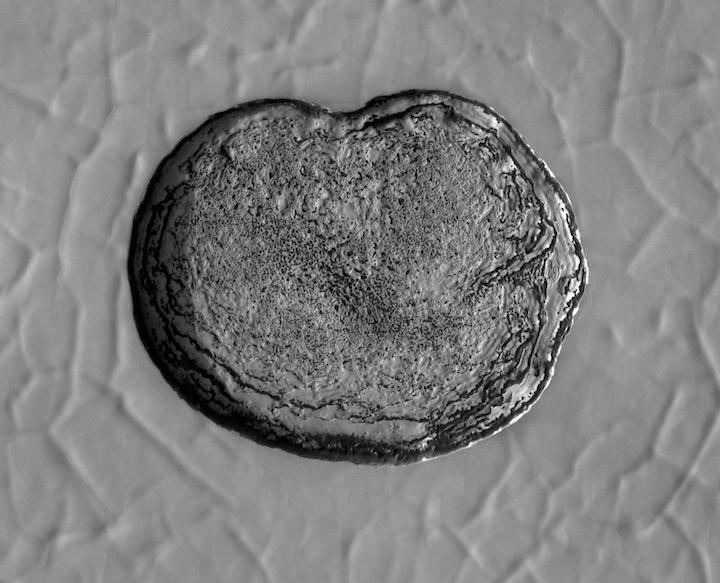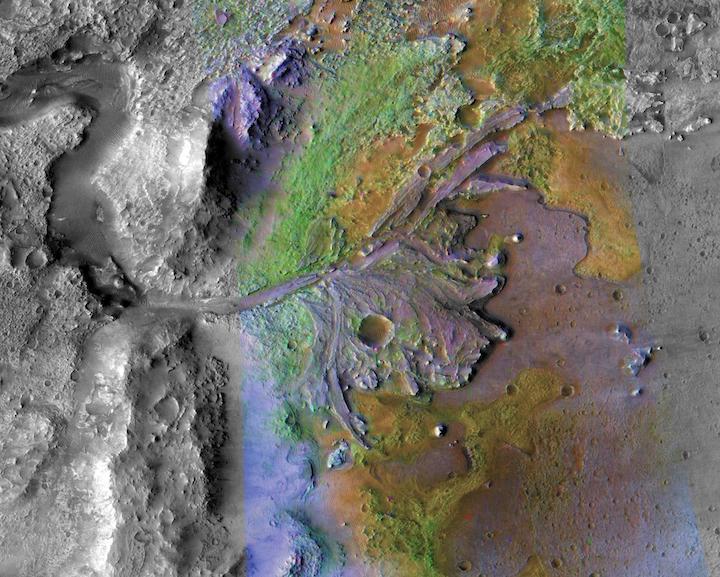16.05.2019

NASA's Mars Reconnaissance Orbiter hit a dizzying milestone this morning: It completed 60,000 loops around the Red Planet at 10:39 a.m. PDT (1:39 p.m. EDT). On average, MRO takes 112 minutes to circle Mars, whipping around at about 2 miles per second (3.4 kilometers per second).
Since entering orbit on March 10, 2006, the spacecraft has been collecting daily science about the planet's surface and atmosphere, including detailed views with its High Resolution Imaging Science Experiment camera (HiRISE). HiRISE is powerful enough to see surface features the size of a dining room table from 186 miles (300 kilometers) above the surface.
Meanwhile, MRO is watching the daily weather and probing the subsurface for ice, providing data that can influence the designs of future missions that will take humans to Mars.
But MRO isn't just sending back its own science; it serves in a network of relays that beam data back to Earth from NASA's Mars rovers and landers. Later this month, MRO will hit another milestone: It will have relayed 1 terabit of data, largely from NASA's Curiosity rover. If you've ever enjoyed one of Curiosity's selfies or sprawling landscapes or wondered at its scientific discoveries, MRO probably helped make them possible.

This series of images shows carbon dioxide ice sublimating (going directly from a solid to a gas) inside a pit at Mars' south pole. As ice is lost from the steep walls of pits like this, it reforms on nearby flat surfaces. Each frame of the animation was taken by the High Resolution Imaging Science Experiment camera (HiRISE) on NASA's Mars Reconnaissance Orbiter.
The images used in this animation were taken between 2007 and 2013. The walls of the pit are about 656 feet (200 meters) across.
The University of Arizona in Tucson operates HiRISE, which was built by Ball Aerospace & Technologies Corp., in Boulder, Colorado. NASA's Jet Propulsion Laboratory, a division of Caltech in Pasadena, California, manages the Mars Reconnaissance Orbiter Project for NASA's Science Mission Directorate, Washington.

This image is of Jezero Crater on Mars, the landing site for NASA's Mars 2020 mission. It was taken by instruments on NASA's Mars Reconnaissance Orbiter (MRO), which regularly takes images of potential landing sites for future missions.
On ancient Mars, water carved channels and transported sediments to form fans and deltas within lake basins. Examination of spectral data acquired from orbit show that some of these sediments have minerals that indicate chemical alteration by water. Here in Jezero Crater delta, sediments contain clays and carbonates.
The image combines information from two instruments on MRO: the Compact Reconnaissance Imaging Spectrometer for Mars (CRISM) and the Context Camera (CTX). The Johns Hopkins University Applied Physics Laboratory in Laurel, Maryland, led the work to build the CRISM instrument and operates CRISM in coordination with an international team of researchers from universities, government and the private sector. Malin Space Science Systems in San Diego built and operates CTX.
NASA's Jet Propulsion Laboratory, a division of Caltech in Pasadena, California, manages the Mars Reconnaissance Orbiter Project for NASA's Science Mission Directorate, Washington. Lockheed Martin Space Systems, Denver, built the orbiter and collaborates with JPL to operate it.
-
"MRO has given scientists and the public a new perspective of Mars," said Project Manager Dan Johnston at NASA's Jet Propulsion Laboratory in Pasadena, California, which leads the mission. "We've also supported NASA's fleet of Mars surface missions, allowing them to send their images and discoveries back to scientists on Earth."
Eyes in the Sky
While rovers and landers can study only their immediate vicinity, orbiters can view wide swaths of the entire planet; MRO can actually target any point on the Martian globe approximately once every two weeks.
MRO's aerial perspective also provides scientists a complementary view of a dynamic planet. As seasons change, they can see avalanches and cloud patterns. HiRISE has imaged CO2 ice sublimating, migrating sand dunes and meteorite strikes reshaping the landscape. With its Mars Climate Sounder instrument and its Mars Color Imager camera, MRO can also study atmospheric events like the massive global dust storm that proved fatal to NASA's Opportunity rover in 2018.
"Mars is our laboratory," said MRO Deputy Project Scientist Leslie Tamppari of JPL. "After more than a decade, we've collected enough data to formulate and test hypotheses to see how they change or hold up over time."
Daily Calls to Earth
MRO is one of several orbiters that send data from Mars to Earth each day. The same way MRO is the primary relay for Curiosity, Odyssey (NASA's longest-lived orbiter) is the primary relay for the agency's latest Martian inhabitant, InSight. The Mars Atmosphere and Volatile Evolution (MAVEN) orbiter recently started changing its orbit in preparation to cover the Mars 2020 rover's entry after it lands in February 2021. After data is sent up to an orbiter, it's beamed to giant antennas at one of three locations around Earth, all of which are part of NASA's Deep Space Network.
That relay network is now international. The European Space Agency's Trace Gas Orbiter has been carrying an ever-increasing share of data sent from the surface. And all of these orbiters are preparing for the arrival of ESA's Rosalind Franklin ExoMars rover, which is scheduled to land the same year as Mars 2020.
Mars Landings
Orbiters like MRO and Odyssey are snap-happy, constantly imaging potential landing sites for future missions. But after a site has been selected and a mission is sent to Mars, orbiters play another critical role.
Before a surface mission can begin conducting science, it has to land safely. Successful landings require clocklike precision so that the spacecraft enters the Martian atmosphere at just the right angle, the parachute opens at the right time and sensors detect the rapidly approaching surface.
MRO and other orbiters serve as black boxes, recording data about each landing, which grow more difficult with the sort of added mass that comes with a mission like Mars 2020. Engineers use the data to design safer missions - which will be key to sending astronauts to Mars. With plans to return astronauts to the surface of the Moon by 2024, NASA is looking ahead at humans exploring the Red Planet, too.
NASA's Jet Propulsion Laboratory, a division of Caltech in Pasadena, California, manages the Mars Reconnaissance Orbiter Project for NASA's Science Mission Directorate in Washington. The University of Arizona in Tucson, operates HiRISE, which was built by Ball Aerospace & Technologies Corp. in Boulder, Colorado. Malin Space Science Systems in San Diego, provided and operates MARCI.
Quelle: NASA

